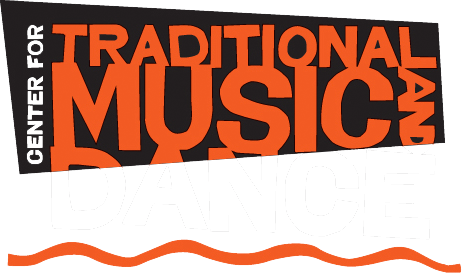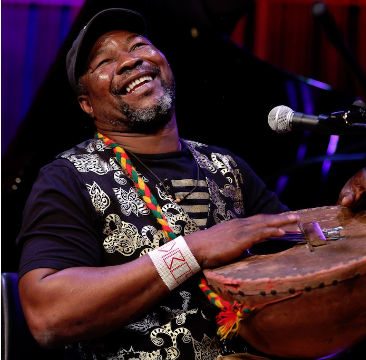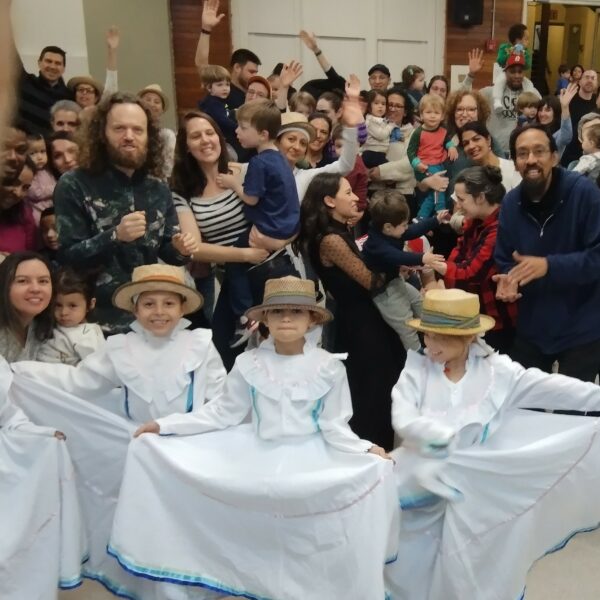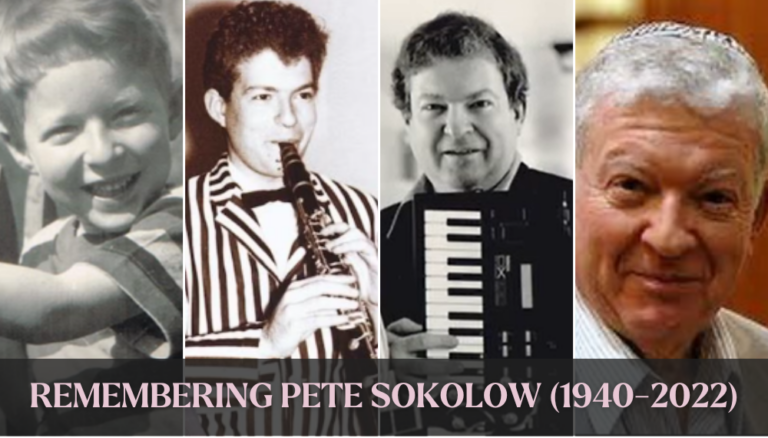As a fellow dulcimer player, I’ve been aware of Brian Cherwick for many years. He’s a multi-instrumentalist and one of the leading researchers and practitioners of the tsymbaly (hammered dulcimer) tradition of the Canadian-Ukrainian immigrants who settled the prairies of Western Canada. Holding a Ph.D. in ethnomusicology/folklore studies, Brian is used to playing the role of the ethnographer, so I was eager to turn the notepad on him for a change as I called him in Edmonton.
Ukrainian Settlement in Western Canada
Brian Cherwick was born in Winnipeg in 1960 into a family that had settled in Canada a couple of generations earlier. Three of his four grandparents were born in the western Ukrainian province of Galicia, from two villages, Chornokonetska Volya and Burdiakivtsi, near the city of Ternopil.
Cultural historians typically identify four waves of immigration from Ukraine to North America — pre WWI, interwar, post-WWII (these are the refugees from Displaced Persons or “D.P.” camps), and post-Soviet. Brian’s father’s family were early settlers from the first wave, immigrating to Saskatchewan in 1903, while his mother’s family came to Manitoba during the interwar immigration in the 1920s.
Most of the immigrants to western Canada were from western Ukraine — the provinces of Bukovina and Galicia which had been wrestled away from the Austro-Hungarian Empire after its collapse in WWI. Brian explains that in the 1890s the Canadian government encouraged settlement of its western territories by Europeans with farming skills. In exchange for a promise to convert forest to agricultural land, settlers could gain large tracts of land for a nominal filing fee.
The largest block of settlers came to East-Central Alberta, with significant additional settlements around the city of Winnipeg in Manitoba as well as Central Saskatchewan. The hundreds of thousands of immigrants created the world’s largest concentration of Ukrainians outside of the mother country. New immigrants settled near fellow family members or friends from their village or town in Ukraine. Canadian immigration authorities would also direct immigrants to settle in particular regions.
According to Brian, Ukrainians were particularly attracted to forest lands because in the home country they would have to pay taxes to land holders to be able to chop wood. The idea of owning a tract full of trees was to a turn-of the 19th century Ukrainian settler a boon that meant that they could escape these reviled tariffs. And the hilly parklands of central Alberta, Manitoba and Saskatchewan reminded them of the Carpathian foothills back home (the prairies flatten out to plains in the southern regions of these provinces). But despite the free land, the settlers worked hard to clear forests and rocks to make their farms suitable for agriculture.
Traditions Transplanted and Transformed
Music and dance have always played important roles in the communal celebrations of the Canadian Ukrainians. The settlers held on to traditions from the old country, especially those associated with the wedding, but adapted them for life in the Canadian prairies.
In Ukraine, a wedding would last several days. Separate banquets would be held at the homes of the bride’s and groom’s families, each with their own musicians. The musicians would play special songs for various prenuptial rituals, such as the preparation of wreaths worn on the heads of the bride and groom during the ceremony and for blessings bestowed by family members. Later, the musicians would march and play as the families and guests proceeded to the church for the ceremony. After the church ceremony there would be a large banquet with music and dancing, emceed by a starosta, a family elder who would announce and direct the rituals at the banquet.
The wide distances between farms in Western Canada necessitated adaptations as wedding participants could often not walk to church. The musicians would save traditional march music for the post-ceremony banquet, playing as each guest arrived in the farm house yard or by the door at the community hall, where modern wedding banquets were more often held. There would typically be two or three seatings for dinner, first a supper for the family, followed by neighbors and guests. After dinner a dance would be held.
Musicians usually made their livings as farmers but were enlisted to play on weekends for weddings, as well as major church festivals and parties. Musicians often found themselves playing in barns or granaries which had been swept out to make room for dance parties.
In earlier times, the basic ensemble was fiddle, tsymbaly and a bubon — which could take the form either of a small tamborine struck with a stick or a large bass drum with a cymbal on top of it. Traditional dances included the “heel/toe polka,” the “seven step,” schottische, chaban, holub and kolomeyka. Choreographed set dances were also performed.
Brian says in his wedding-going experience, all the dances performed were couples dances with the exception of the rare arkan, a choreographed circle dance for men that is seldom performed at weddings today and the “butterfly,” a dance loosely based on the traditional metelytsia dance for a group of three dancers (either one man and two women, or one woman and two men). The musicians would sometimes adapt traditional melodies to new choreographic needs. For example, a Ukrainian folksong could be retrofitted with a foxtrot rhythm to accommodate this popular dance.
Music in the Cherwick Family
Growing up in the Ukrainian North End neighborhood of Winnipeg, Brian says Ukrainianness was an organic element of his family life. Brian grew up as the oldest of five children and spoke Ukrainian at home (though Ukrainian fluency has waned with the younger siblings). Although their home didn’t look too different from that of non-Ukrainians families, it smelled like a Ukrainian home from the aroma of the kitchen. Cuisine, like music, is an important marker of ethnic identity for many Canadian-Ukrainians, and Brian’s family was particularly engaged in culinary arts — both of his grandmothers worked as part-time caterers for weddings and festivals.
Brian had music on both sides of his family. His father’s father, John Cherewyk, left the farm to become a harness maker and later a meat cutter in the town of Yorkton, Saskatchewan. But on the side, John played fiddle in a trio with his two brothers — one playing tsymbaly and the other adding a second violin.
John additionally trained as a cantor in the Ukrainian Catholic church. Known in Ukraine as Ukrainian Greek Catholic or Uniate, this movement follows Eastern Orthodox rites but recognizes the spiritual primacy of the Pope. Brian learned the cantorial art from his grandfather (as well as other cantors) during church services each Sunday and would come back with him and hear him fiddling at home. Brian holds a position today as a cantor in his church and is active in teaching liturgical singing to fellow congregants.
On his mother’s side, Brian’s great-grandfather was a fiddler and his grandmother even played the small bubon in the band until she was old enough to marry (it was not respectable then for mature women to play music). Brian’s uncle Mike Klym played drum kit with the D-Drifters, one of the most famous Western Canadian Ukrainian bands.
The D-Drifters were especially known for providing backup to Mickey and Bunny, a famous singing married couple, and for recording country western music with English and Ukrainian lyrics. Their biggest hit was a Ukrainian translation of Woody Guthrie’s “This Land is Your Land,” and the disc sold hundreds of thousands of copies. Uncle Mike was only fifteen years older than Brian, and so Brian grew up going to practices of the D-Drifters.
Brian formed his first band with friends at age 14, and began playing violin at weddings at age 15. Instrumentation has changed with the tastes of the community, and modern bands often feature accordions, keyboards, saxes, electric guitars, basses and drum kits (such adaptation is not a new phenomena — grandfather John Cherewyk also performed on the Hawaiian-style lap steel guitar which was a rage in the 20s and 30s).
The Tsymbaly
At age 16, Brian acquired a tsymbaly from his brother who had gotten it from a church group. The tsymbaly is a trapezoidal instrument with about 100 strings that the player strikes with small hammers in a manner akin to playing a xylophone. The tsymbalist can play melodies or provide harmonic/rhythmic accompaniment patterns for a violinist, flutist or other lead instrumentalist.
Tsymbaly has a long tradition in Ukraine. According to dulcimer historian Paul Gifford, the instrument evolved from the German dulcimer known as “hackbrett” (literally “chopping board”) that developed in the 15th century in the Rhein Valley and migrated into Eastern Europe. It is still commonly heard at village weddings in the Carpathian mountains.
When Brian was getting started with the instrument in the 1970s, the tsymbaly’s popularity was affected by two countervailing trends. On one hand, most of the bands wanted to modernize and shed vestiges of old-world instrumentation. However, there was also a roots movement which encouraged a number of young musicians to play traditional tunes and instruments. Tsymbaly was particularly important to the Ukrainians of Canada because the instrument was unique to their community, unlike the violin, which was shared by the French, Swedish and Metis (of mixed French Canadian and First Nations ethnicity) communities.
The instrument reflected the Western Ukrainian roots of the community. It should be noted that in Eastern Canada and the United States, with larger immigrant populations from Eastern Ukraine, the bandura (a harp-lute that is considered to be the national instrument of Ukraine) is the main instrumental marker of Ukrainianness rather than the tsymbaly (for more on the bandura tradition see the May 2007 Master Artist profile of Julian Kytasty). Brian is also an accomplished bandurist, and has mastered over twenty other Ukrainian traditional instruments (for a sample of some Brian’s prodigious talents, see a short clip of him on YouTube).
Several towns across Western Canada hold (or held) Ukrainian ethnic festivals featuring tsymbaly. The most well-known include the annual competitions/festivals in Dauphin (Manitoba), Vegreville (Alberta) and the Red Barn event in Bon Accord (Alberta). Ken Huculuk has been a major promoter of the instrument, through his record label Heritage Records and support of competitions.
The attention to the instrument provided incentive for players to develop virtuosic melodic playing styles which were less commonly heard in earlier immigrant bands (where the tsymbaly was mainly used for chordal accompaniment to a violin). And demand for instruments supported the craft of a number of tsymbaly makers.
Brian’s Musical Development
As a young musician with an entrepreneurial flair, Brian saw tsymbaly as a way to differentiate his band and their advertisements would promote the fact that they played the old tunes on traditional instruments as well as in more modern arrangements. Brian learned tsymbaly from watching the old-timers play at weddings (with over 100 first-cousins, there were plenty of family celebrations throughout the year). He also listened to regional Canadian-Ukrainian commercial recordings featuring tsymbaly— bands such as those of the Alberta fiddlers Metro Radomsky, Bill Boychuk, and Manitoba fiddlers Jim Gregorash, Tommy Buick and Peter Lamb, as well as the Interlake Polka Kings.
Brian entered Brandon University (about 100 km west of Winnipeg) to study in its well regarded music program. Though tsymbaly was not offered, he enrolled as a pianist and percussionist. After graduating, Brian spent four years teaching music and conducting choirs at a seminary in Roblin, Manitoba, a tenure that was interrupted mid-way by an opportunity to study music for a year in Ukraine.
Brian had received an invitation from the Society for Relations with Ukrainians Abroad (actually a goodwill initiative of the KGB). Based at the Kyiv Conservatory, Brian took classes in cimbalom, the piano-sized concert version of the tsymbaly that had developed in Hungary at the end of the 19th century and was taught in conservatories in Hungary, Ukraine, Czechoslovakia, Romania and Moldova. Adapting from tsymbaly to cimbalom requires learning a completely different tuning system, sticking technique and use of the cimbalom’s damper pedal, which is similar to that of a piano.
Though his assigned teacher was Gyorgi Ahratina, who played cimbalom with the national folk orchestra, Brian learned more from Vasyl Palaniuk, an ethnic Hutsul from the Carpathians who was the senior cimbalom student at the conservatory and is today recognized as one of Ukraine’s leading players. While Palaniuk played cimbalom in the conservatory ensemble, Brian would play percussion alongside of him as they accompanied highly choreographed folkloric dance presentations.
From Roblin, Brian moved to Edmonton to enroll in the University of Alberta’s graduate programs in Ukrainian folklore and ethnomusicology. His Ph.D. dissertation on Ukrainian Dance Bands followed significant stylistic turning points in the music’s history, as well as the development of the Canadian-Ukrainian commercial recording industry.
The Kubasonics
Today Brian lives in Edmonton, and describes himself as a “utility guy” (given his prowess on a multitude of instruments) for a number of bands. His main ensemble, the Kubasonics, are renowned for mixing old time music with more contemporary sounds and arrangements. The group’s varied repertoire includes traditional songs played traditionally, contemporary arrangements of traditional songs and original English language songs that explore Ukrainianness (most of which provide humorous commentary on the Canadian-Ukrainian identity).
The Kubasonics’ personnel has adapted over time. Brian’s wife was the band’s original fiddler before sadly passing away, and his brother Paul was their drummer before he moved to California. Today the lineup includes Brian on a range of instruments, a well known folk fiddler of Scandinavian descent named Rod Olstad, guitarist Jay Lind, drummer Thom Bennett and bassist Taras Zakordonski. Increasingly, a new generation of Cherwicks are seen on the stage– Brian’s teenage daughter Maria regularly performs as a violinist with the band and his eight-year old son Jacob can “keep up with most of the tunes” on drums.
Brian says that working with non-Ukrainians has strengthened the arrangements as they bring in influences from a variety of different musics. These innovations have propelled the Kubasonics to become recognized as one of the unique and leading voices in Canada’s roots music scene.
As for the tsymbaly, Brian reports that the instrument is once again on a modest upswing in popularity. Brian has a few regular students and a colleague, Steven Cwok, has been active in recruiting and training new players. While accordions are the most popular lead instruments for most of the bands playing at weddings, festivals and large community dances, tsymbaly players and fiddlers playing traditional repertoire have found an active market for their talents in dances for senior citizens which are held almost every night of the week in Edmonton.
Brian Cherwick will be featured along with dance ethnographer Andriy Nahachewsky as part of CTMD’s program “Sounds of the Prairies: Music and Dance of the Ukrainian Settlers of Western Canada” that runs from October 16th -22nd. For more on the tsymbaly tradition see Brian’s article “Ukranian Tsymbaly Performance in Alberta,” published in the Canadian Journal for Traditional Music (1995), and available on the internet at the following link: http://cjtm.icaap.org/content/23/v23art3.html
Also recommended is Mark Bandera’s book “The Tsymbaly Maker and His Craft: The Ukrainian Hammered Dulcimer in Alberta” (Canadian Institute of Ukrainian Studies Press, 1991). Bandera also wrote a 1983 article for the Canadian Journal of Traditional Music entitled “The Western Canadian Championships: Tsymbaly Competitions at the Red Barn” which may be found here: http://cjtm.icaap.org/content/11/v11art5.html
The best history of hammered dulcimers (including tsymbaly) across a wide spectrum of ethnic traditions is Paul Gifford’s book “The Hammered Dulcimer: A History” (Scarecrow Press, 2001).




